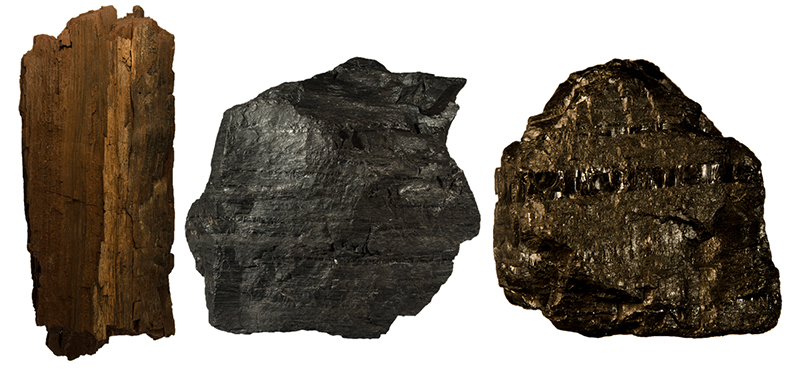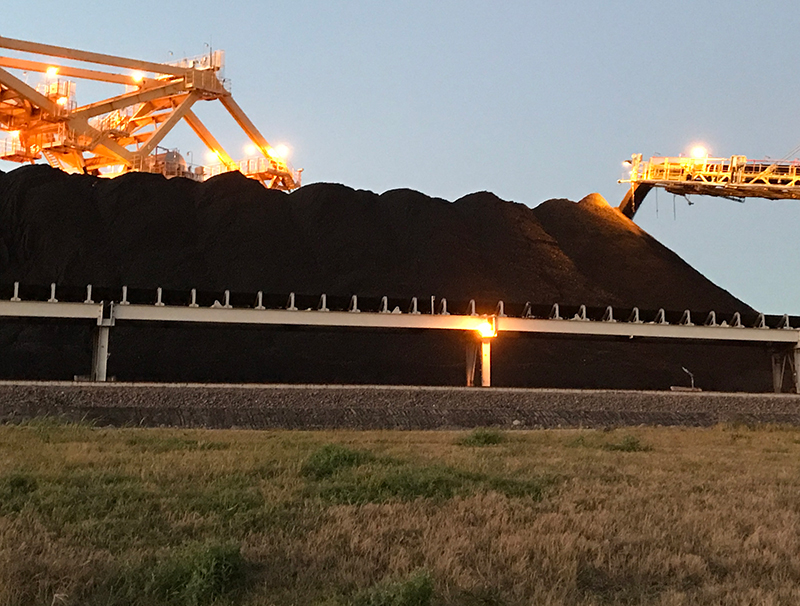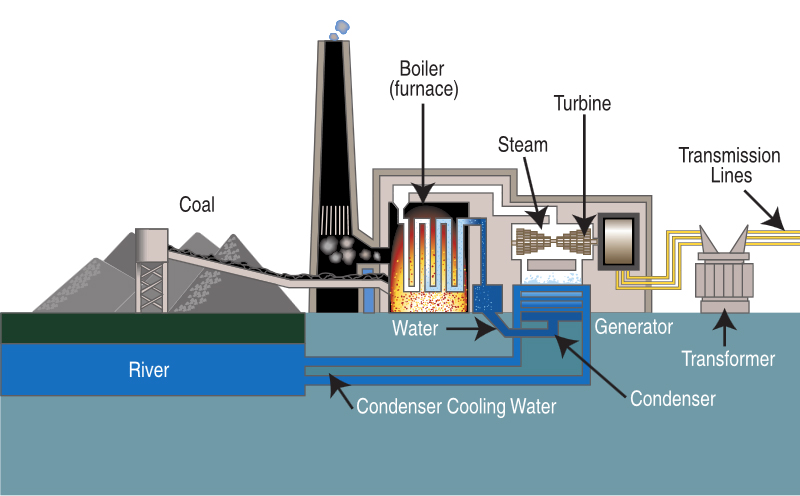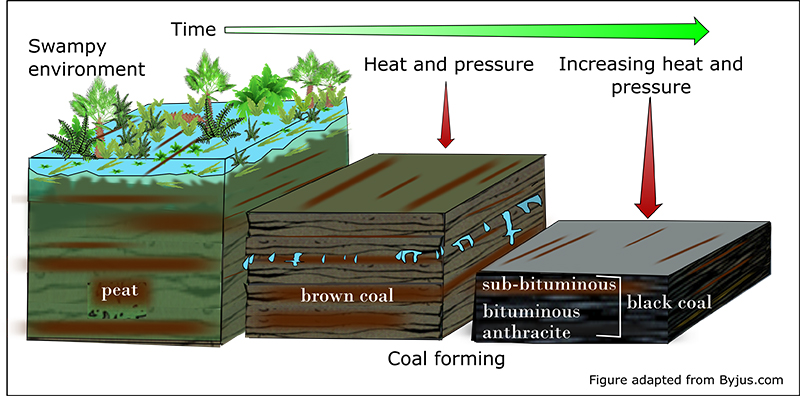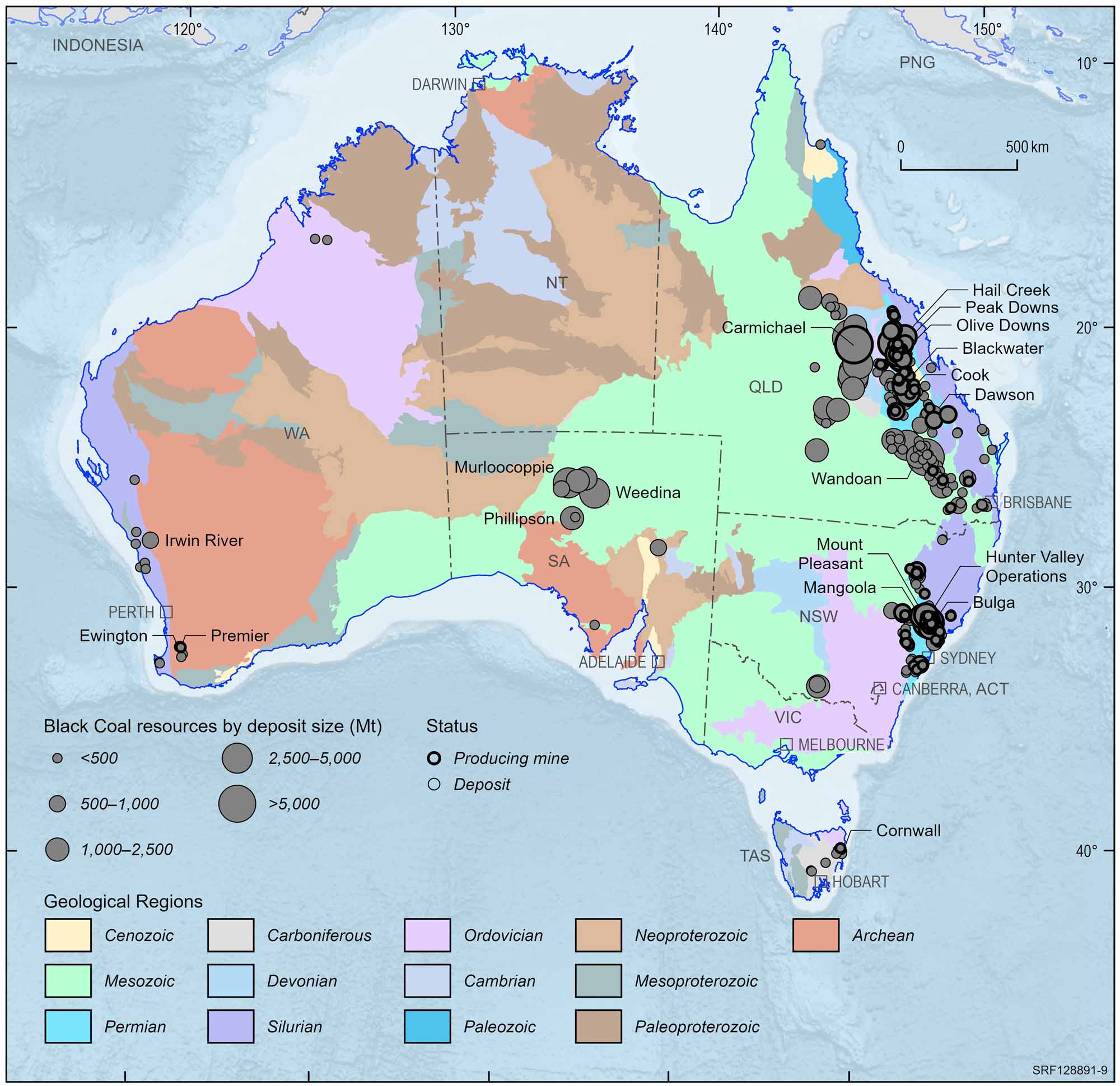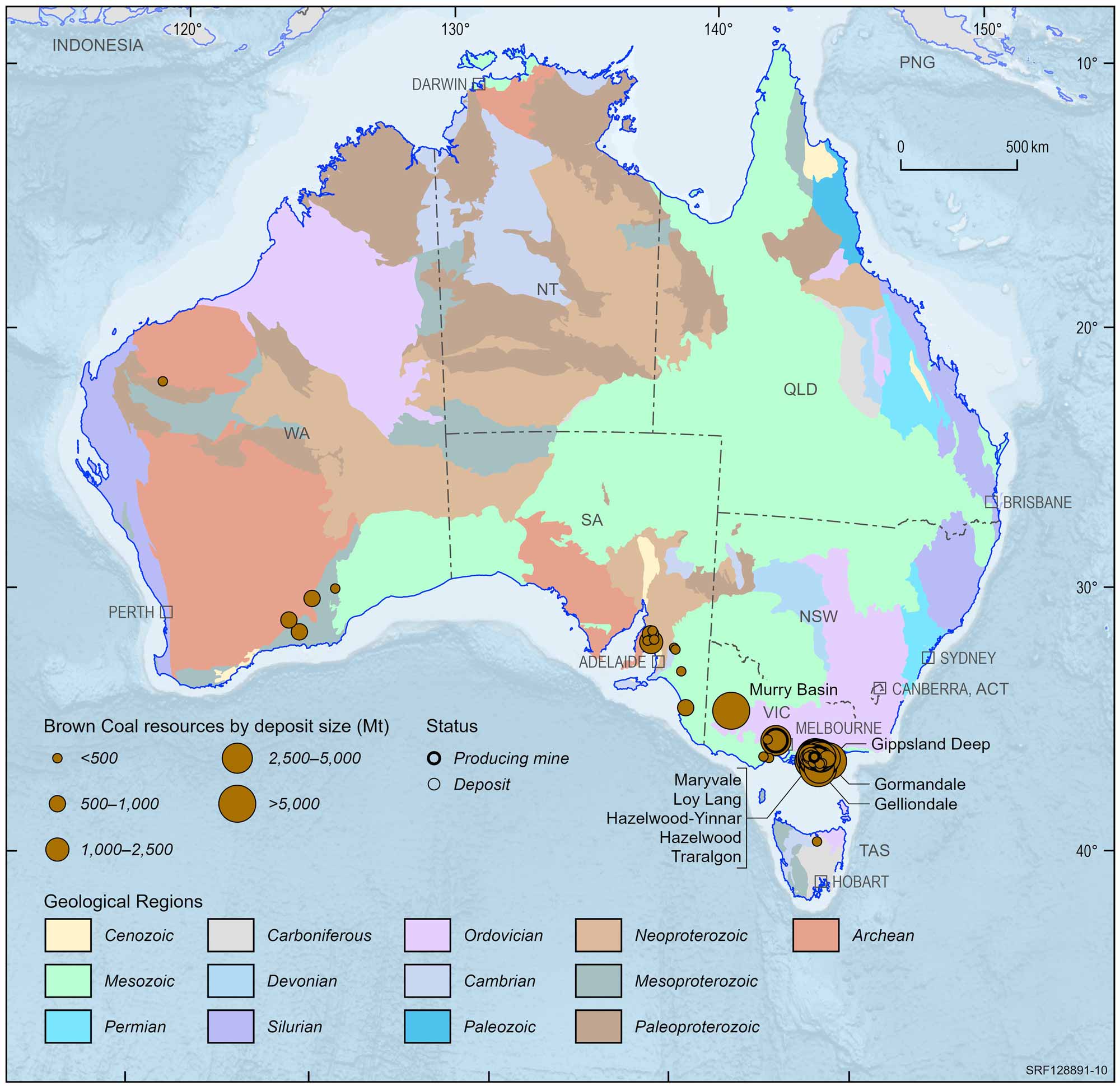Coal
Last updated:1 September 2023
Introduction
Coal is classified as a sedimentary rock. It is a common non-renewable fuel used mainly in the production of electricity. It is a fossil fuel because it forms from dead plant matter. The quality of coal depends on how it formed; as the organic matter is subjected to greater heat and pressure, the carbon content increases.
Brown coal, sub-bituminous black coal (R30126) and bituminous black coal. Source: Geoscience Australia.
Properties
Coal is a combustible rock mainly composed of carbon along with variable quantities of other elements, mostly hydrogen, sulphur, oxygen and nitrogen. Coal occurs as layers, called coal beds or coal seams, that are found between other sedimentary rocks. Coal is slightly denser than water but less dense than most of the rocks of the Earth's crust. The density varies depending on how porous (full of holes) the coal is. Sometimes the pores contain a gas called methane.
Coal properties vary depending on how much carbon is in the coal (coal rank). Black coal is so called because of its colour; it varies from having a bright, shiny lustre to being very dull, and from being relatively hard to soft. The term 'black coal' is used in Australia to refer to anthracite, as well as bituminous and sub-bituminous coals. Brown coal is also called lignite; it contains less carbon and so has less chemical potential energy than black coal and has more moisture in it.
| Type of coal / material | Other names | Properties | Approximate carbon content (dry ash-free basis) | |
|---|---|---|---|---|
| Peat | An organic sediment. It is considered to be a precursor of coal. | Less than 60% | ||
| Brown coal | Lignite | Usually yellow to dark brown in colour and can have a woody appearance or recognisable plant structures in it. | 60 to 70% | |
| Black coal | Sub-bituminous coal | Black lignite | Dark brown to black in colour. It does not have a woody appearance and often has alternating bands of dull and bright material. | 70 to 76% |
| Bituminous coal | Soft coal, steam coal or rock coal. | A dense, usually black, but sometimes dark brown rock, often with well-defined bands of bright and dull material. The dull bands can contain sedimentary mineral grains. | 76 to 86% | |
| Anthracite | Hard coal | A harder, glossy black coal. It is the highest rank of coal meaning the carbon content is highest. | Over 86% | |
Coal stockpiles at Port Waratah coal terminal New South Wales. Source: Michelle Cooper, Geoscience Australia.
Uses
Brown and black coal are mostly used as a source of fuel for power stations. Burning the coal produces heat which is used to make steam, so the the coal is sometimes called thermal or steam coal. The steam spins turbines to generate electricity. In Australia in 2017 coal was used to produce about 60% of the nation's electricity requirements. Using brown coal for power generation is problematic because of the high water content. It crumbles easily on exposure to the air which reduces its value as a fuel and requires specialised storage. It has also been known to spontaneously combust. Since the 1970s the amount of natural gas used to generate electricity has increased and there has been a gradual decline in the use of coal for power. The amount of greenhouse gases generated by burning gas for energy is far less than the volume produced by burning coal.
Certain types of bituminous coal are used to make an essential raw material for making steel — coke. This type of coal is also called metallurgical (steel making) coal and it is processed to produce coke. Coke is a hard porous substance composed of about 90% carbon, it is vital for making steel which is used in millions of items such as cars, trucks, fire engines, refrigerators and bridges.
Coal and peat is still used for residential and commercial heating in some parts of the world (e.g. Ireland and Finland). In its dehydrated form, peat is a highly effective absorbent for fuel and oil spills on land and water. It is also used as a conditioner for soil to make it more able to retain and slowly release water.
Diagram of a typical steam-cycle coal power plant (proceeding from left to right). Coal burned in the boiler heats water to produce steam. The steam spins the turbine, which drives the generator. Source: Wikimedia Commons.
Coal is also an important source of light aromatic hydrocarbons for the chemical synthesis industry. If coal is heated the gases and residues produced can be used in manufacturing plastics, explosives, dyes, pitch, ammonia, medicines, aspirin, soap, disinfectant, detergents, nylons, cosmetics, shampoo, toothpaste, synthetic rubber, fertilizers, cement, bricks and tiles. It is an important ingredient used in filters for water and air purification and in kidney dialysis machines. In addition coal is used to make carbon fibre, a very strong, light material used in construction, mountain bikes and tennis rackets.
Jet, a compact form of brown coal, is sometimes polished and has been used as an ornamental stone. Graphite which is often associated with coal, is almost entirely made of carbon; it is mostly used in pencils and when powdered, as a lubricant.
Coal is an important ingredient used in shampoo, conditioner, cosmetics; toothpaste and detergents. Source: Geoscience Australia.
History
The earliest recognized use of coal is from the Shenyang area of China around 4000 BC where black lignite was carved into ornaments. Coal from the Fushun mine in north-eastern China was used to smelt copper as early as 1000 BC. Marco Polo, the Italian who travelled to China in the 13th century, described coal as "black stones ... which burn like logs", and said coal was so plentiful, people could take three hot baths a week.
Coal was used in Britain during the Bronze Age (3000-2000 BC) in funeral pyres (wooden structure used to burn a body).The Romans were mining coal in England and Wales by the end of the second century AD. Evidence of trade in coal (dated to about AD 200) has been found at the Roman settlement near Chester and in East Anglia. In Rhineland, deposits of bituminous coal were used by the Romans for the smelting of iron ore. In 1257-59, coal from Newcastle upon Tyne was shipped to London for the smiths and lime-burners who were building Westminster Abbey.
Easily accessible sources of coal had largely become exhausted (or could not meet the growing demand) by the 13th century, when underground extraction by shaft mining was developed. The alternative name was 'pitcoal', because it came from mines. As steam engines took over from water wheels during the Industrial Revolution large-scale mining and use of coal grew. In 1700, five-sixths of the world's coal was mined in Britain.
In Australia, black coal was first discovered in Newcastle in 1791 and coal mining and exports commenced in 1799. These early coal mining activities made a significant contribution to the progress of European settlement in Australia. The spread of settlers to other locations in Australia lead to further discoveries. Mining of black coal occurred near Ipswich Queensland in 1825; at Cape Paterson, Victoria in 1826; and Irwin River, Western Australia in 1846. Knowledge of the existence of brown coal in Victoria dates back to 1857 and the Yallourn North open-cut began production in 1889. In 1878, Taronga Zoo was to be the site of an underground coal mine until the mining company was stopped by Parliament. Instead, coal was mined in Balmain until 1931.
Formation
Coal is formed in sedimentary basins. Sedimentary basins are regions where the Earth has subsided or sunk down. Water and sediments then flow into the basin and they fill with layers of sediments. Australia's black coal resources range from Permian to Jurassic in age (299 to 145 million years old), although most are Permian in age. During this time, the climate was warm in Australia, and Eastern Australia, including the Sydney Basin was covered by large, meandering rivers, marshes, bogs and swamps. The sediments deposited in these environments eventually formed rocks such as shale, sandstone and coal. Brown coal in Australia formed more recently than the black coals. These are mostly of Paleogene age (66 to 23 million years old).
Coal is a sedimentary rock formed when abundant plant material is covered by sediments and the material accumulates faster than it can decay. The weight of the overlying sediments compacts the organic layers, increasing the temperature and pressure, which leads to physical and chemical changes to the plant material. Water, carbon dioxide and methane are produced and escape, so the material becomes progressively enriched in carbon. With increasing time, and higher heat and pressure, the plant material first forms into peat, then is converted into brown coal, then sub-bituminous coal, bituminous coal, and lastly anthracite.
Resources
Australia has the fourth-largest share of coal reserves in the world. Since the late 1700s about 9100 million tonnes of black coal and about 2300 million tonnes of brown coal have been mined in Australia and the industry still provides significant employment, capital investment and domestic and export income to the national economy.
Australian black coal deposits and operating mines, 2022.
Deposit size is based on total recoverable resources (EDR + Subeconomic Demonstrated Resources + Inferred).
For clarity, only major or significant deposits are labelled.
Australian brown coal deposits and operating mines, 2022.
Deposit size is based on total recoverable resources (EDR + Subeconomic Demonstrated Resources + Inferred).
For clarity, only major or significant deposits are labelled.
Black coal resources occur in New South Wales, Queensland, South Australia, Tasmania and Western Australia but New South Wales and Queensland have the largest share of Australia's total identified resources. These two states are also the largest coal producers. Australia's principal black coal producing basins are the Bowen Basin (Queensland) and Sydney Basin (New South Wales). Locally important black coal mining operations also include Collie in Western Australia, and Fingal and Kimbolton in Tasmania.
Brown coal occurs in South Australia, Western Australia, Tasmania, Queensland and Victoria. The Gippsland Basin in Victoria contains a substantial world-class deposit where seams can be up to 330 m thick. The Otway Basin (Victoria), the Murray Basin (Victoria and South Australia), the North St Vincents Basin (South Australia) and the Eucla Basin (Western Australia) also contain significant brown coal resources. Minor resources occur in Tasmania's Longford Basin. Currently, brown coal is only mined in Victoria where the open-cut mines at Loy Yang and Yallourn supply coal to nearby power stations. Brown coal is also mined at Maddingley to produce soil conditioners and fertilisers. Other products from Victorian brown coal are briquettes for industrial and domestic use and low-ash and low-sulphide char products.
Coal is one of Australia's largest commodity exports with annual exports. In 2016 coal exports from Australia mainly went to Japan, India, European Union, Republic of Korea and Taiwan; they were worth about $40 billion.
Further coal resource and production information and Australia's Identified Mineral Resources.
Mining
In Australia, nearly 80% of coal is produced from open-cut mines, in contrast to the rest of the world where open-cut mining only accounts for 40% of coal production. Open-cut mining is possible because coal seams are close to the surface. Such mining is cheaper than underground mining and enables up to 90% recovery of the resource. Many brown coal beds lie close to the surface and can be hundreds of metres thick, so can be extracted easily and cheaply. Firstly the topsoil is removed and stored for use later in restoring the disturbed land. The surface rock (called overburden) covering the coal is then blasted with explosives and removed by excavators. The uncovered coal is in turn then blasted to break up the layers and loaded into large trucks which can hold up to 300 tonnes of material. The coal is transported to the processing plant where impurities are removed.
Coal that is deeper than a few hundred metres under the surface must be extracted using two underground mining methods. Some coal is mined by the Bord and Pillar method. This is where a machine continually cuts into the coal. It tunnels through the coal seams leaving pillars supported by roof bolts to hold up the roof. An alternative is longwall mining, which uses a large cutting blade to slice across the coal layer to remove the coal seam. The coal is then transported to the surface on a conveyor belt. After the coal is mined the machine is dismantled and relocated to another section of the mine allowing the roof to collapse behind.
Advances in technology have led to the introduction of automated longwall mining systems. In addition, some mining companies are using driverless trucks, trains and drones to improve safety and gather information.
Processing
Black coal can be used without any processing, but is usually crushed, screened and sorted according to customer requirements. Sometimes it is also washed to remove any pieces of waste minerals that do not burn. This improves the quality and reduces the production of ash when the coal is burned. To wash the coal it is placed into tanks with liquids and chemicals which assist in recovering more of the coal as it floats to the surface. The coal is then left to dry out. It is stored according to size and may be blended, again according to customer specifications. From there it is stockpiled or stored in bins ready for transport by road or rail.
Lower quality coal such as sub-bituminous or brown coal can be refined to remove moisture and other impurities. This increases the efficiency of the coal as a fuel and reduces emissions of greenhouse gases and other pollutants, when the coal is burned. In Victoria the brown coal is upgraded by the Coldry Process. A mechanical shear is used to crush the coal into small particles, releasing water that was held in the pores (holes) in the coal. The process produces a denser coal in pellet form.
